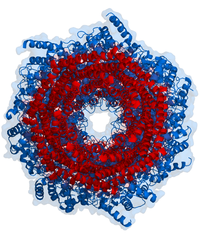
Photo from wikipedia
Abstract An efficient photodegradation of roxarsone (ROX) was achieved by using synthesized zinc oxide (ZnO) nanoplates under UV light irradiation. ZnO nanoplates were synthesized by facile wet chemical method. Characterization… Click to show full abstract
Abstract An efficient photodegradation of roxarsone (ROX) was achieved by using synthesized zinc oxide (ZnO) nanoplates under UV light irradiation. ZnO nanoplates were synthesized by facile wet chemical method. Characterization of ZnO nanoparticles was done by X-ray diffraction (XRD), Fourier transform infrared (FT-IR) spectroscopy, diffuse reflectance (DRS) UV–Visible absorption spectroscopy, BET analyzer, scanning electron microscopy (SEM) and transmission electron microscopy (TEM). The obtained results reveal that the synthesized sample is ZnO which has hexagonal structure and plate-like morphology. The band gap and specific surface area of ZnO was found to be 3.02 eV and 7 m 2 g −1 respectively. ROX’s degradation by-products such as As(III), As(V) were analyzed by high performance liquid chromatography-hydride generation coupled with atomic absorption spectrometry (HPLC-HG-AAS). The photogenerated hydroxyl ( ) and carbon-centered radicals were detected by electron paramagnetic resonance (EPR) spectroscopy. According to experimental evidences a possible photocatalytic mechanism has also been proposed. Photocatalytic degradation of ROX leads to mineralization as CO 2 and As(V). This can be considered as a promising method for removing ROX from contaminated waters.
Journal Title: Solar Energy
Year Published: 2017
Link to full text (if available)
Share on Social Media: Sign Up to like & get
recommendations!